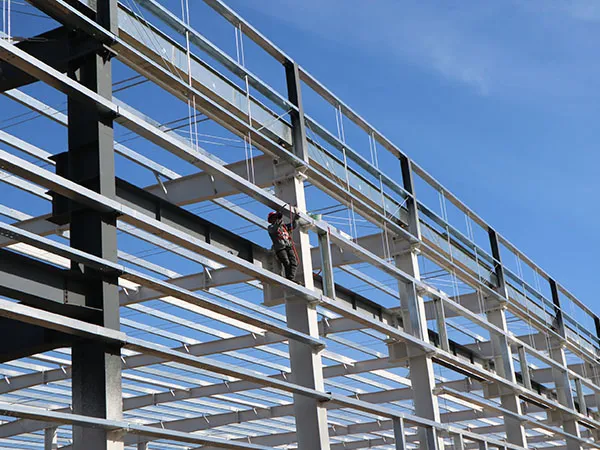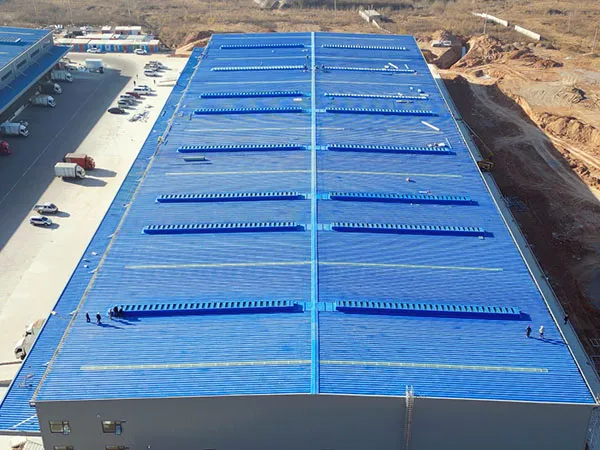Time:2025-03-21 08:16:17 Source:Sanjian Meichen Steel Structure
In modern industrial construction, steel structures, with their exceptional strength, durability, construction efficiency, and environmental advantages, have become an irreplaceable choice. Whether it's large-scale factories, warehouses, logistics centers, or production workshops and specialized industrial facilities, steel structures offer flexible and reliable solutions. However, with so many design, material, and construction options available, choosing the industrial steel structure that best suits your project's needs is crucial. This article will delve into the key factors, optimization strategies, and latest trends in industrial steel structure selection to help you make informed decisions and ensure project success.
Choosing a quality industrial steel structure is a significant investment that requires careful consideration. A poorly constructed structure can lead to safety issues, costly repairs, and operational inefficiencies.
First, let's review why industrial steel structures are so popular:
Excellent Strength and Load-Bearing Capacity: Steel's high strength-to-weight ratio means that while providing strong load-bearing capacity, component size can be reduced, increasing usable space.
Short Construction Period: Steel structural components can be prefabricated in the factory, requiring only on-site installation, significantly shortening the construction period and reducing total project costs.
High Design Flexibility: Steel structures allow for large spans and spacious designs, facilitating equipment layout and optimizing production processes to meet future expansion needs.
Environmentally Friendly and Sustainable: Steel is recyclable, reducing construction waste and aligning with green building principles.
Excellent Seismic Performance: Steel structures have excellent ductility and can absorb energy under seismic loads, enhancing building safety.
Adaptability: They can adapt to various complex terrains and climates, meeting the needs of diverse industrial production environments.

Project Function and Purpose:
Production Workshop: Consider equipment loads, vibration, production processes, lighting, and ventilation requirements.
Warehouse/Logistics Center: Focus on storage capacity, stacking height, forklift access, fire safety, and rapid loading and unloading.
Specialty Industrial Facilities (e.g., Chemical, Power): Consider corrosive environments, explosion-proof requirements, special equipment support, and safe evacuation.
Span and Height: Determine the optimal span and clearance height based on the production line, storage requirements, and equipment size.
Load Condition Analysis:
Dead Loads: Structure deadweight, fixed equipment, roof and wall materials.
Live Loads: Equipment movement, personnel, cargo stacking, crane loads, etc.
Wind Loads: Assess the impact of wind on the structure based on the project location, building height, and shape.
Snow Loads: Consider snow pressure on the roof in cold regions.
Seismic Loads: Conduct seismic design based on the design intensity.
Special Loads: Dynamic loads such as vibration, impact, and equipment startup/shutdown.

Material Selection and Specifications:
Steel grades: Q235B, Q345B, etc., selected based on strength and toughness requirements. Higher-strength steel may be required for heavy-load or long-span structures.
Anti-corrosion treatment: Select an appropriate anti-corrosion treatment based on the environmental corrosiveness (atmospheric corrosion, chemical corrosion), such as rust-proof paint, fire-retardant coating, or galvanizing.
Enclosure system: Color-coated steel plates, composite panels, brick walls, etc., should consider insulation, sound insulation, fire resistance, and aesthetics.
Structural form and system:
Portal frame: Economical and efficient, suitable for large-span, lightweight industrial buildings.
Truss structure: Suitable for industrial buildings with larger spans and heavier loads.
Frame structure: Ideal for multi-story or high-rise industrial buildings.
Reticulated shell/tensile membrane structure: Suitable for special shapes or large space requirements.
Support system: Ensures the overall stability and lateral force resistance of the structure.

Fire and Corrosion Design:
Fire Rating: Determine the fire resistance limit of the steel structure based on factors such as the building's purpose, fire hazard, and evacuation distance, and implement appropriate fire protection measures (fire-retardant coatings, cladding).
Corrosion Prevention Strategy: Develop a scientific corrosion prevention plan tailored to the specific corrosive environment to ensure the long-term stable operation of the structure.
Budget and Economy:
Material Cost: Steel grade, quantity, and corrosion treatment method.
Processing and Fabrication Cost: Component complexity and factory processing efficiency.
Transportation and Installation Cost: Site conditions, lifting difficulty, and labor costs.
Post-Maintenance Cost: Consider maintenance costs throughout the structure's lifespan.
Energy Cost: The impact of the building envelope's insulation performance on operational energy consumption.
Construction Technology and Team:
Select a design and construction team with extensive experience in industrial steel structure projects.
Ensure that the construction process complies with national and industry standards, focusing on quality control and safety management.
Focus on factory prefabrication capabilities and on-site installation efficiency.
To make your industrial steel structure projects more competitive, consider the following optimization and innovation areas:
Application of BIM (Building Information Modeling) Technology:
Full Lifecycle Management: Enable data sharing and collaborative work from design and construction to operations and maintenance.
Clash Detection: Predictively identify and resolve conflicts between structures, equipment, and pipelines.
Cost and Schedule Optimization: Accurately budget and simulate construction processes to improve efficiency.
Visual Communication: Enhance project understanding and decision-making efficiency for all parties.
Green and Sustainable Design:
Energy-Saving Enclosure Systems: Use high-performance insulation materials to reduce heating and cooling energy consumption.
Natural Lighting and Ventilation: Optimize the layout of windows and skylights to reduce the need for artificial lighting and mechanical ventilation.
Rainwater Harvesting and Reclaimed Water Reuse: Conserve water resources.
Renewable Energy Integration: Install rooftop solar panels to provide partial electricity.
Intelligent Integration:
Intelligent Lighting Systems: Automatically adjust based on light intensity and occupant activity.
Environmental Monitoring Systems: Real-time monitoring of temperature, humidity, air quality, and other parameters, automatically adjusting the lighting. Remote
Equipment Monitoring and Diagnostics: Improve operational efficiency and reduce downtime.
Prefabrication and Modularization: Maximize factory prefabrication to reduce on-site workload and improve construction accuracy and speed.
Modular design facilitates future expansion or modification.
New Materials and Technologies:
High-Strength Steel Application: Further reduce steel usage, enabling lighter and larger structures.
New Anti-Corrosion and Fire-Resistant Materials: Enhance structural safety and durability.
Robotic Welding Technology: Improve welding quality and efficiency.
Choosing an experienced and technically competent supplier is crucial to project success:
Qualifications and Certifications: Ensure the supplier possesses relevant national qualifications and industry certifications.
Project Experience: Understand their successful cases and expertise in similar industrial projects.
Design and R&D Capabilities: Whether they have a professional design team and can provide customized solutions.
Production and Processing Capabilities: Investigate the factory's equipment, production processes, and quality control systems.
Construction and Installation Services: Understand their on-site management, safety measures, and after-sales service. Credibility and Reputation: Refer to customer reviews and industry reputation.
Selecting an industrial steel structure is a systematic process, involving extensive expertise and decision-making. By thoroughly understanding project requirements, fully considering various technical and economic indicators, and incorporating the latest design concepts and construction techniques, you will be able to create an industrial building that is functional, safe, reliable, cost-effective, and sustainable. Choose Meichen Steel, and our professional team will provide you with comprehensive services, from design consultation and material supply to fabrication, manufacturing, and installation, ensuring the complete success of your industrial steel structure project. We are committed to providing innovative, high-quality steel structure solutions, and together we contribute to the vigorous development of China's industry.